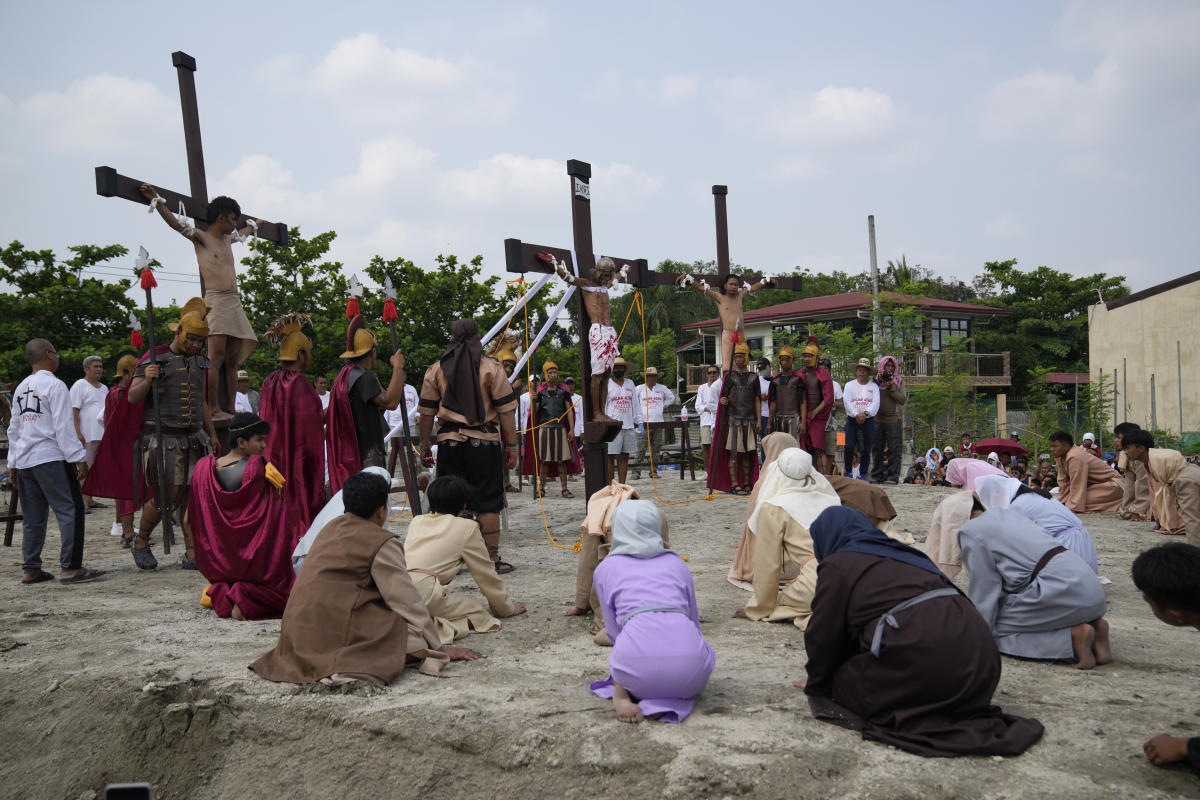SAN PEDRO CUTUD, Philippines (AP) — At least 12 Filipinos will be nailed to crosses to reenact the suffering of Jesus Christ in a bloody Good Friday tradition rejected by the Catholic Church but drawing huge crowds of devotees and tourists to the Philippines , an Asian stronghold of Christianity.
Real-life crucifixions in the farming village of San Pedro Cutud in Pampanga province north of Manila resumed after a three-year hiatus due to the coronavirus pandemic. At least 12 men were to take part, including 62-year-old draftsman painter Ruben Enaje, who will be nailed to a wooden cross for the 34th time in Cutud and two other nearby villages, organizers said.
Enaje said he would use his extraordinary penitence, likely one of his last due to his age, to pray for the eradication of the COVID-19 virus and the end of the Russian invasion of Ukraine, which has helped bring the gas and food prices have soared worldwide.
“I really want to stop this because of my age, but let’s see if my body can still bear the pain next year,” Enaje told The Associated Press a few days before the crucifixions.
The father of four has been portrayed in some media reports as one of the bravest men in the world for the annual achievement “but to be honest I’m always nervous because I could end up dead on a cross.”
“When I lie on the crotch, my body starts to feel cold. When my hands are tied, I just close my eyes and say to myself, ‘I can do this. I can do this,” he said.
Surviving almost unscathed when he fell from a three-story building in 1985, he had to endure the ordeal in thanks for what he considered a miracle. He expanded the ritual after loved ones recovered from serious illnesses, one after another, turning him into a village celebrity as the “Christ” in the Lent re-enactment of the Stations of the Cross.
Before their crucifixion on a dusty hill, Enaje and the other devotees, wearing thorny crowns of twigs, carried heavy wooden crosses on their backs for over a kilometer (more than half a mile) under the scorching heat. Village actors dressed as Roman centurions later drove 4-inch (10-centimeter) stainless steel nails through his palms and feet, then set him on a cross under the sun for about 10 minutes.
Other penitents walk barefoot through village streets, beating their bare backs with sharp bamboo sticks and pieces of wood. In the past, some participants opened cuts in the penitents’ backs using broken glass to ensure the ritual was sufficiently bloody.
The gruesome spectacle reflects the Philippines’ unique Catholicism, which fuses church traditions with folk superstitions.
Many of the mostly impoverished penitents undergo the ritual of atoning for sins, praying for the sick or for a better life, and giving thanks for miracles.
Church leaders in the Philippines have expressed disapproval of the crucifixions and self-flagellations, saying that Filipinos can show their deep faith and religious devotion without hurting themselves and instead do charitable work such as donating blood.
Robert Reyes, a prominent Catholic priest and human rights activist in the country, said the bloody rites reflect the church’s failure to fully educate many Filipinos in the Christian teachings, leaving them to their own devices to explore personal ways to seek divine help for all sorts of ailments. .
Folk Catholicism has become deeply entrenched in the local religious culture, Reyes said, referring to a chaotic procession of a black image of Jesus Christ called the Black Nazarene that draws more than a million devotees each January, authorities said in a statement. of Asia’s greatest religious festivals. Many bring towels to wipe the wooden statue, believing it to have the powers to cure ailments and ensure good health and a better life.
“The question is where were we church people when they started this?” Reyes asked, saying the clergy should immerse themselves more in communities and talk to villagers regularly. “When we condemn them, we just alienate them.”
Decades of crucifixions, meanwhile, have put impoverished San Pedro Cutud, one of more than 500 villages in the rice-producing province of Pampanga, on the map.
Organizers said they expect about 20,000 foreign and Filipino tourists and devotees to gather for the cross nails. While villagers sold bottles of water, hats, food and religious items, police and marshals kept order.
“They like this because there really isn’t anything like this on Earth,” said Johnson Gareth, a British tour organizer, who brought 15 tourists from eight countries, including the United States, Canada and Germany, to witness the crucifixions. “It is less gruesome than people think. They think it will be very macabre or very disgusting, but it is not. This is done in a respectful manner.”
In the past, Gareth said tourists were “genuinely inspired and I think they left with a newfound respect for people’s beliefs.”
___
Associated Press journalists Aaron Favila and Cecilia Forbes contributed to this report.

